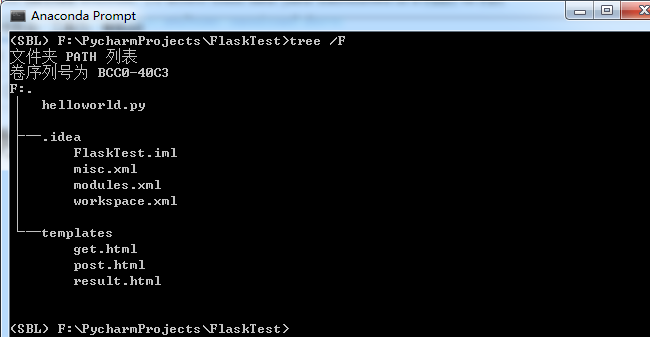Python3+Flask安装使用教程
一、环境配置
当前我的开发环境是Miniconda3+PyCharm。开发环境其实无所谓,自己使用Python3+Nodepad都可以。安装Flask库:
pip install Flask
二、第一个应用程序
将以下内容保存为helloworld.py:
# 导入Flask类 from flask import Flask # 实例化,可视为固定格式 app = Flask(__name__) # route()方法用于设定路由;类似spring路由配置 @app.route('/helloworld') def hello_world(): return 'Hello, World!' if __name__ == '__main__': # app.run(host, port, debug, options) # 默认值:host="127.0.0.1", port=5000, debug=False app.run(host="0.0.0.0", port=5000)
直接运行该文件,然后访问:http://127.0.0.1:5000/helloworld。结果如下图:

三、get和post实现
3.1 创建用到的模板文件
Flask默认到templates目录下查找模板文件,在上边helloworld.py同级目录下创建templates文件夹。
在templates文件夹下创建get.html,写入以下内容:
<!DOCTYPE html> <html> <head> <meta charset="utf-8"> <title>get请求示例</title> </head> <body> <form action="/deal_request" method="get"> <input type="text" name="q" /> <input type="submit" value="搜索" /> </form> </body> </html>
再在templates文件夹下创建post.html,写入以下内容:
<!DOCTYPE html> <html> <head> <meta charset="utf-8"> <title>post请求示例</title> </head> <body> <form action="/deal_request" method="post"> <input type="text" name="q" /> <input type="submit" value="搜索" /> </form> </body> </html>
最后在templates文件夹下创建result.html,写入以下内容:
<!-- Flask 使用Jinja2模板引擎,Jinja2模板引擎源于Django板模所以很多语法和Django是类似的 --> <h1>{{ result }}</h1>
3.2 编写相关的处理方法
在helloworld.py中添加get_html()、post_html()和deal_request()三个方法,更多说明见注释。当前helloworld.py内容如下:
# 导入Flask类 from flask import Flask from flask import render_template from flask import request # 实例化,可视为固定格式 app = Flask(__name__) # route()方法用于设定路由;类似spring路由配置 #等价于在方法后写:app.add_url_rule('/', 'helloworld', hello_world) @app.route('/helloworld') def hello_world(): return 'Hello, World!' # 配置路由,当请求get.html时交由get_html()处理 @app.route('/get.html') def get_html(): # 使用render_template()方法重定向到templates文件夹下查找get.html文件 return render_template('get.html') # 配置路由,当请求post.html时交由post_html()处理 @app.route('/post.html') def post_html(): # 使用render_template()方法重定向到templates文件夹下查找post.html文件 return render_template('post.html') # 配置路由,当请求deal_request时交由deal_request()处理 # 默认处理get请求,我们通过methods参数指明也处理post请求 # 当然还可以直接指定methods = ['POST']只处理post请求, 这样下面就不需要if了 @app.route('/deal_request', methods = ['GET', 'POST']) def deal_request(): if request.method == "GET": # get通过request.args.get("param_name","")形式获取参数值 get_q = request.args.get("q","") return render_template("result.html", result=get_q) elif request.method == "POST": # post通过request.form["param_name"]形式获取参数值 post_q = request.form["q"] return render_template("result.html", result=post_q) if __name__ == '__main__': # app.run(host, port, debug, options) # 默认值:host=127.0.0.1, port=5000, debug=false app.run()
3.3 查看运行效果
重新运行helloworld.py。
当前目录结构如下(.idea目录不用管):

get.html如下:

get查询结果如下:

post.html如下:

post查询结果如下:

四、restful
所谓restful简单理解就是以json等格式(而非以前的表单格式)发起请求,及以json等格式(而非以前的html)进行响应。
等下我们通过curl模拟rest请求,然后使用jsonify实现rest响应。
4.1 服务端实现代码
# 导入Flask类 from flask import Flask, jsonify from flask import render_template from flask import request # 实例化,可视为固定格式 app = Flask(__name__) # route()方法用于设定路由;类似spring路由配置 #等价于在方法后写:app.add_url_rule('/', 'helloworld', hello_world) @app.route('/helloworld') def hello_world(): return 'Hello, World!' # 配置路由,当请求get.html时交由get_html()处理 @app.route('/get.html') def get_html(): # 使用render_template()方法重定向到templates文件夹下查找get.html文件 return render_template('get.html') # 配置路由,当请求post.html时交由post_html()处理 @app.route('/post.html') def post_html(): # 使用render_template()方法重定向到templates文件夹下查找post.html文件 return render_template('post.html') # 配置路由,当请求deal_request时交由deal_request()处理 # 默认处理get请求,我们通过methods参数指明也处理post请求 # 当然还可以直接指定methods = ['POST']只处理post请求, 这样下面就不需要if了 @app.route('/deal_request', methods=['GET', 'POST']) def deal_request(): if request.method == "GET": # get通过request.args.get("param_name","")形式获取参数值 get_q = request.args.get("q","") return render_template("result.html", result=get_q) elif request.method == "POST": # post通过request.form["param_name"]形式获取参数值 post_q = request.form["q"] return render_template("result.html", result=post_q) @app.route('/rest_test',methods=['POST']) def hello_world1(): """ 通过request.json以字典格式获取post的内容 通过jsonify实现返回json格式 """ post_param = request.json result_dict = { "result_code": 2000, "post_param": post_param } return jsonify(result_dict) if __name__ == '__main__': # app.run(host, port, debug, options) # 默认值:host=127.0.0.1, port=5000, debug=false app.run()
4.2 请求模拟
curl -H "Content-Type:application/json" -X POST --data '{"username": "ls","password":"toor"}' http://127.0.0.1:5000/rest_test
4.3 效果截图

五、Flask与Django比较
5.1 Django配置复杂
如果对Django不是很了解,可以参看“Python3+PyCharm+Django+Django REST framework开发教程”和“Python3+Django get/post请求实现教程 ”。
仅从文章长度看就比这篇长很多,所以Django比Flask复杂(得多)是肯定的。更具体比较如下:
| 比较项 | Django | Flask | 复杂度比较 | 说明 |
| 项目创建 | Django需要用命令创建项目 | Flask直接编写文件就可运行 | Django复杂 | Django需要用命令创建项目是因为要创建出整个项目框架 |
| 路由 | Django使用专门的urls.py文件 | Flask直接使用@app.route() | Django笨重 | Django类似Strut2的配置Flask类似Spring的配置,Flask感觉更好 |
| get和post | request.GET['name']和request.POST["name"] | request.args.get("name","")和request.form["q"] | 差不多 | Flask格式上不统一 |
| restful | 使用django-resful框架 | 使用jsonify | 差不多 | Flask不需要单建一个app,更直观一些 |
| 数据库操作 | django集成了对数据库的操作 | Flask没集成对数据库的操作要另行直连或使用sqlalchemy | 差不多 | django复杂很大程度来源于对数据库的集成。 |
5.2 Flask和Django各自适合使用场景
我们经常会听说这样的一个近乎共识的观点:Django是Python最流行的Web框架但配置比较复杂,Flask是一个轻量级的框架配置比较简单如果项目比较小推荐使用Flask。
进一步来说,Flask的轻量来源其“暂时不用的功能都先不做处理”,Django复杂来源于其“可能用到的功能都先集成”;随着项目规模的扩大最终Django有的东西Flask也都需要有。
所以,如果平时你用python是东用一个库西用一个库,东写一个场景西写一个场景,而不是专门开发web,那么你适合使用Flask,因为这样你的学习成本低及以前的知识都能用上去。
如果你平时使用python主要是开发web,那么建议使用Django,因为如果你都用到那么Django的东西就不是多余的,而且系统的一套知识就是“正规军”而不是Flask般的“乌合之众”。
参考:



